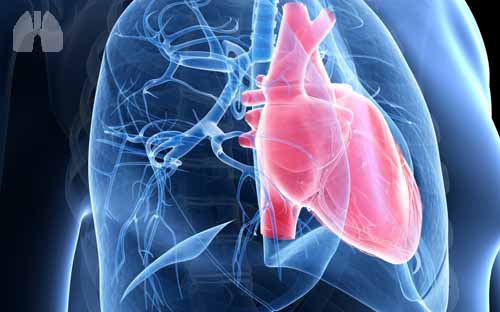
Daisy Duan, Chenjuan Gu, Jonathan C. Jun
European Respiratory Journal 2020 55: 2000447; DOI: 10.1183/13993003.00447-2020
Glucose and fat metabolism are altered in pulmonary arterial hypertension, but it is not yet clear if these changes are causes or effects of the disease http://bit.ly/3cWyf66
Pulmonary arterial hypertension (PAH) is characterised by progressive obliteration of the pulmonary vasculature, culminating in right-sided heart failure (HF). In recent years, studies have observed an association between systemic metabolic dysfunction, PAH and right ventricular failure. Patients with PAH have an increased prevalence of obesity and type 2 diabetes. Interestingly, abnormal glucose metabolism is evident even in non-diabetic individuals with PAH, and serves as an independent predictor of prognosis. Right ventricular function is also associated with metabolic syndrome, and myocardial tissue in mouse models of PAH exhibit defects in fatty acid oxidation associated with increased lipid deposition. In addition, peroxisome proliferator-activated receptor-γ (PPARγ), a master regulator of adipogenesis and glucose homeostasis, has been implicated in the pathogenesis of vascular remodelling and subsequent development of PAH. PPARγ is also a downstream target of bone morphogenic protein receptor 2 (BMPR2). BMPR2 mutations are seen in up to 80% of hereditary PAH, and BMPR2 sporadic mutations occur in idiopathic PAH. A rodent model of inducible BMPR2 overexpression develops insulin resistance preceding features of PAH. Collectively, these observations suggest that impaired glucose metabolism may be a causative factor in PAH. However, most of the clinical data above is derived from cross-sectional studies with very limited metabolic outcomes.
In this issue of European Respiratory Journal, Mey et al. utilised hyperglycaemic clamp methodology and plasma metabolomics to further characterise metabolism in patients with idiopathic PAH (n=6) compared to age-, sex- and BMI-matched controls (n=6). To perform the hyperglycaemic clamp, glucose was infused at a variable rate to maintain continuous hyperglycaemia (180 mg·dL−1). Levels of insulin and C-peptide were measured to quantify pancreatic β-cell function, while the rate of glucose infused was used as a surrogate for insulin sensitivity. During the clamp, the authors found that peripheral insulin concentrations were lower in subjects with PAH, which translated to a 92% increase in insulin sensitivity in the PAH group. Hepatic insulin extraction (calculated as insulin/C-peptide molar ratio) was greater in PAH than in controls. However, pancreatic β-cell insulin secretion, as assessed by C-peptide concentrations, was similar between the two groups. In addition, PAH was associated with increased fatty acid oxidation and ketogenesis, as evidenced by elevated acetylcarnitine and β-hydroxybutyrate (βOHB) levels. The authors confirmed this metabolic shift using plasma metabolomics in a larger cohort of PAH patients. Interestingly, hepatic insulin extraction had a positive correlation while free fatty acids (FFA):βOHB ratio had a negative correlation with greater 6-min walk distance. The investigators suggested that increased hepatic insulin extraction mediates reduced insulin response to hyperglycaemia and may contribute to impaired glucose tolerance in PAH. Also, they proposed that upregulated conversion of FFA to βOHB may be a beneficial metabolic adaptation in PAH.
There are several novel findings to this study, which is the first to apply hyperglycaemic clamp methodology to PAH. Given that PAH is associated with insulin resistance in other contexts, it is surprising that PAH patients exhibited increased insulin sensitivity and hepatic insulin extraction. Upon closer examination, however, other studies in PAH have also found decreased insulin concentrations during oral glucose tolerance testing which indirectly suggests greater insulin sensitivity (calculated by HOMA-IR). Hepatic insulin extraction is typically reduced in individuals with impaired glucose tolerance, diabetes [19], and obesity, and contributes to the hyperinsulinaemia associated with these pathological states. Thus, altered glucose metabolism in PAH may be distinct from the insulin resistance seen in obesity and early type 2 diabetes.
There are several potential explanations for the metabolic changes described in this article. Insulin concentrations are significantly influenced by first pass hepatic metabolism, in which approximately 50% of secreted insulin is extracted. Generally, excess carbohydrate/energy intake reduces hepatic insulin clearance while low carbohydrate/energy intake increases hepatic insulin clearance. Increased hepatic insulin clearance has also been described in catabolic states such as exercise and weight loss. During exercise, low insulin is thought to be physiologically important to enhance lipolysis and fat utilisation in order to meet the energy demands of the exercising muscles. In this study and in previous work by the same investigators, basal metabolic rate was elevated in PAH, perhaps due to chronically increased cardiac workloads. Indeed, patients with reduced left ventricular ejection fraction manifest low insulin concentrations and increased hepatic insulin clearance. Melenovsky et al. speculate that low insulin and high glucagon levels facilitate myocardial utilisation of fatty acids and ketones. In support of this, both animal and human studies demonstrate that ketone bodies are utilised as an alternative fuel in HF. Hence, the low insulin, ketogenic state found in this PAH study bears a resemblance to other energetically costly states such as exercise and HF.
There are limitations to this study, some of which were acknowledged by the authors. The insulin/C-peptide ratio was used as an index of hepatic insulin extraction, but may over-simplify different distribution kinetics and half-lives of C-peptide and insulin. Next, the hyperglycaemic clamp is the gold standard to assess pancreatic β-cell function, but is not optimal for measuring insulin sensitivity. The latter is estimated by the M/I ratio (quantity of glucose metabolised per unit of plasma insulin) and does not account for effects of hyperglycaemia itself on glucose uptake or inactive pro-insulin in the circulation. Instead, the euglycaemic–hyperinsulinaemic clamp (infusing insulin while titrating glucose to normal levels) is the more reliable method to assess insulin resistance. Regardless of technique, these methods can only provide information about glucose homeostasis at the whole body level, and not in specific compartments, such as the right ventricle or pulmonary vasculature. Finally, the study has a small sample size with unclear generalisability to PAH or other forms of pulmonary hypertension.
We applaud the authors of this study for shedding new light on glucose and nutrient metabolism in PAH. However, the role of metabolism in PAH is still in its infancy. A paramount question remains whether these metabolic abnormalities are “the fire” (causes), “the smoke” (consequences), or mere spectators in the PAH narrative. We should seek improved understanding of these metabolic shifts before therapies targeting these pathways are investigated.
Footnotes
-
Conflict of interest: D. Duan has nothing to disclose.
-
Conflict of interest: C. Gu has nothing to disclose.
-
Conflict of interest: J.C. Jun has nothing to disclose.
-
Support statement: This work was supported by the National Institutes of Health (T32DK062707 to D. Duan), American Heart Association (Postdoctoral Fellowship Award 20POST35210763 to C. Gu), National Institutes of Health (R01HL135483 to J.C. Jun). Funding information for this article has been deposited with the Crossref Funder Registry.
- Received February 26, 2020.
- Accepted February 29, 2020.
- Copyright ©ERS 2020














